Electricity and Magnetism Demos List
1. ELECTROSTATICS
1.1 - Electric Charge
1.1A Producing Electric Charge
Charge a pith ball or an electroscope by touching it with a plastic or glass rod,
rubbed with cloth.
[Set-Up Time: 5 min.]
1.2 Electric Force
1.2A Pith Balls
Charge two pith balls suspended next to each other and observe repulsive (or attractive)
electric force between them.
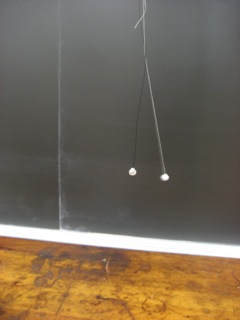
[Set-Up Time: 5 min.]
1.2B Freely Rotating Conducting Rod
Show attraction between a charged plastic rod and a conducting rod which is
supported by a needle and can rotate freely.
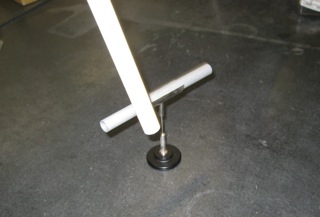
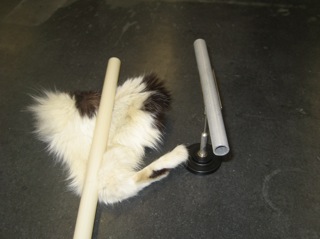
[Set-Up Time: 5 min.]
1.2C Deflection of Water Stream
Show that a charged plastic rod held near a stream of water will deflect it.
[Set-Up Time: 5 min.]
1.3 Induced Charge
1.3A Pith balls
Bring a charged rod close to an uncharged pith ball (or a suspended uncharged
metal rod) to show attraction.
[Set-Up Time: 5 min.]
1.3B Charging an Electroscope by Induction
Bring a charged rod close to an electroscope - observe charging by induction.
Extension: With the charged rod close by and electroscope charged by inductin,
touch the electroscope. Remove both charged rod and your hand, observe charge
staying on the electroscope.
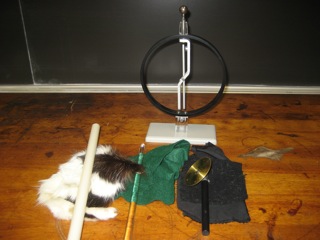
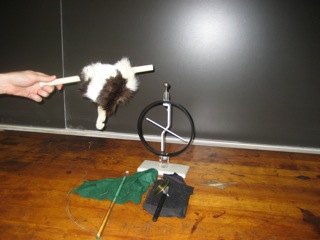
[Set-Up Time: 5 min.]
1.3C Kelvin Water Dropper
Water falls through two metal tubes and is collected in two cans connected by
an "X" arrangement to opposite receivers. When enough charge builds up on the
cans, they discharge and light a small lamp connecting them
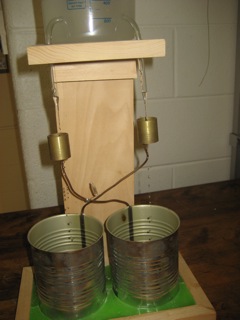
[Set-Up Time: 5 min.]
1.4 Electrostatic Machines
1.4A Van der Graaff Generator
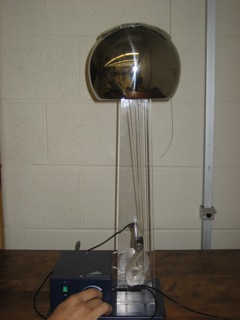
[Set-Up Time: 5 min.]
Back to Top


2. ELECTRIC FIELDS AND POTENTIAL
2.1 - Electric Fields
2.1A Flying Pie-Tins
Place a stack of aluminum pie-tins on top of the Van der Graaff generator. The
pie-tins will lift up and float away one by one as the Van der Graaff is charged.
[Set-Up Time: 10 min.]
2.1B Van der Graaff Ping-Pong
Suspend a conducting ball between the Van der Graaff and a grounded sphere and
watch it bounce back and forth continuously.
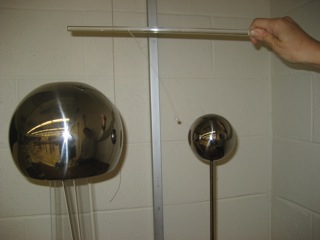
[Set-Up Time: 10 min.]
2.1C Extent of Electric Field
Place an electroscope several feet away from the Van der Graaff generator and
observe its charging and discharging.
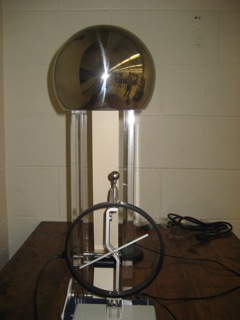
[Set-Up Time: 10 min.]
2.1D "Hair" on Van der Graaff Generator
Tape a few strands of string on the Van der Graaff generator, observe them spike
up after the generator is turned on.
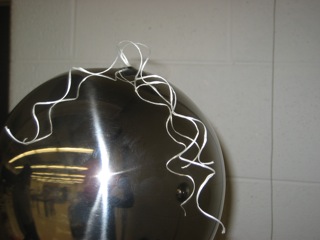
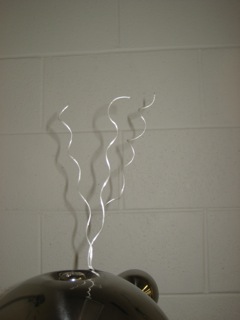
[Set-Up Time: 10 min.]
2.2 Gauss' Law
2.2A Faraday Cage (with Van der Graaff)
Set-up "Extent of Electric Field" above, then place a Faraday cage over the electroscope.
Show that the electroscope no longer responds.
[Set-Up Time: 10 min.]
2.2B Faraday Cage (with Tesla Coil)
A small neon lamp will light when placed within the field of a Tesla coil. Cover
the lamp with the Faraday cage and the lamp goes out.
[Set-Up Time: 5 min.]
2.2C Radio in a Cage
A small radio will be silenced when covered with a Faraday cage.
[Set-Up Time: 5 min.]
Back to Top


3. CAPACITANCE
3.1 - Parallel-Plate Capacitor
One plate of a parallel-plate capacitor is connected to ground and the other to
an electroscope. The capacitor can be charged, and the plate separation can be
continuously varied.

[Set-Up Time: 10 min.]
3.2 - Effect of Dielectric on a Capacitor
Insert a dielectric (e.g. a book) between the plates of a charged capacitor, and
observe the effect on an electroscope.
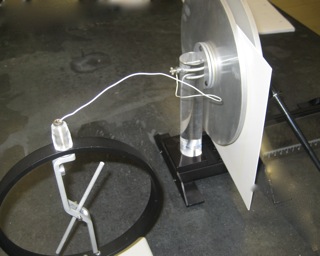
[Set-Up Time: 10 min.]
Back to Top


4. RESISTANCE AND CONDUCTION
4.1 - Playdoh Resistor
Connect a piece of playdoh to an ohmmeter. Watch how its resistance changes as
you mold it into various shapes.
[Setup time: 15 mins.]
4.2 - Air Conduction
Charge an electroscope, then bring the flame of a match nearby and watch the electroscope
discharge.
[Set-Up Time: 5 min.]
Back to Top


5. ELECTROMOTIVE FORCE AND CURRENT
5.1 - Lemon-Powered Clock
Copper and zinc electrodes areinserted into a lemon. The other ends of the electrodes
are connected to the battery compartment of a digital clock. Watch the clock running!
[Set-Up Time: 10 min.]
Back to Top


6. MAGNETIC FIELDS AND FORCES
6.1 - Oersted Effect
A compass needle is deflected near a current-carrying wire. Reverse the flow of current and the needle also reverses direction.
[Set-Up Time: 15 min.]
6.2 -Magnets and Iron Filings
Iron filings or an array of compass needles show the field lines due to various magnets. Displayed on the overhead.
[Set-Up Time: 10 min.]
6.3 -Forces on Moving Charges
The e/m apparatus produces an electron beam which is made to “dance” when a permanent magnet is waived by the tube.
[Set-Up Time: 10 min.]
Back to Top


7. ELECTROMAGNETIC INDUCTION
7.1 - Induction Coil with Magnet
An induction coil connected to a galvanometer shows the current induced by inserting and removing a magnet.
[Set-Up Time: 5 min.]
7.2 -Magnets and Iron Filings
Similar to the one above, but an electromagnet is used in place of the magnet. The flux can be changed by either moving the electromagnet or varying the current through it.
[Set-Up Time: 5 min.]
Back to Top


8. AC Circuits
8.1 - RLC, RC, RL Circuits
Create a circuit on a breadboard or a spring board, power by a Pasco function generator, and measure across the resistor with an oscilloscope.
[Set-Up Time: 10 min.]
8.2 - Oscilloscope
Demos can be set up with an oscilloscope.

[Set-Up Time: 10 min.]
Back to Top


Back to Barnard College, Physics and Astronomy Department


